 Hello, all you two-leggeds out there. I’ve been told to introduce myself. I am Lucinda, the Literate Cat. This website is named after me because I am so remarkable.
Hello, all you two-leggeds out there. I’ve been told to introduce myself. I am Lucinda, the Literate Cat. This website is named after me because I am so remarkable.
To put you completely in the picture, I am the cat that owns your cantankerous cat lady. Actually, I can understand how she got that name. In my eyes, she is ancient beyond my ability to imagine. She is so old she has been owned by a number of cats during her lifetime. No wonder she is cantankerous!
The cantankerous cat lady has hired me to do a job for her. I didn’t become a literate cat by accident. I have read lots of books. The job I have been hired to do is to write book summaries of some of the books I have read.
We had to agree on terms. I told her I would only do reviews of books about animals, because I could understand them. Too many of the books the two-leggeds write have no meaning to me at all. She agreed to this request.
However, then she tried to influence me as to the way I would write the summaries. She wanted them to be “truth” in the way she sees it. I don’t always see things the same way, and I can only express things from my point of view. She may not agree with the way I interpret these stories, but she will have to live with it.
Still, she hired me.
So, on to the reviews. All of these books are hardcover editions of classic children’s stories. My “boss” was always given hardcover children’s books when she was growing up, and she says they became treasures to her. These books have all been around for many years. A hardcover copy of the book will last long enough for the young one to keep it and pass it on to her offspring.
The Complete Tales of Beatrix Potter’s Peter Rabbit
Hardcover; priced at $ 22.65; ships from Amazon by prime. Includes the stories of Peter Rabbit, Benjamin Bunny, Tale of Mr. Toad, Tale of the Flopsy Bunnies.
This book is a collection of animal stories for the small two-legged child. It is illustrated with sweet drawings and contains tales of the creatures’ adventures.
These stories are obviously meant to teach the two-legged some things it did not learn from its mother before it was weaned. The purpose of the book is quite apparent, as all these creatures are wearing clothes. I have never seen a rabbit wearing clothes. I guess with clothes, they are something a young two-legged child might identify with more closely.
Personally, I feel clothes on a rabbit look a bit ridiculous. It seems to me clothing would restrict their movements too much. After all, rabbits are often the prey for big-game hunter cats. My friend, Carlos, rest his soul (he was the last cat who owned the cantankerous cat lady) was an avid rabbit hunter, bringing home animals nearly as big as he. He told me they tasted delicious, but I have never eaten one. I would rather curl up in my soft chair and read about them.
The stories in the book are meant to emphasize things the young two-legged animals need to learn. The most important lesson seems to be “do what your mother tells you.” These creatures get in all sorts of trouble because they are disobedient. The mother is smart, because one of the things she warns her young ones about is the cat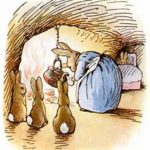 . If they want to reach adult rabbithood, they had better pay attention to that warning!
. If they want to reach adult rabbithood, they had better pay attention to that warning!
Peter Rabbit always got into lots of trouble because he didn’t do what his mother told him. He knew his mother had said not to go near the garden, but of course he had to go.
After all, there were good things to eat in there, especially delicious carrots. So, in Peter hopped, looking around cautiously for danger.
Now comes the good part. The cat who patrolled the garden was smart, wily, and evil. On this day, the cat came by on a regular patrol and saw the rabbit.
…and what happened next? Well, you will have to read the book to find out.
I think your youngster would enjoy these stories in spite of the lessons they try to teach.
Alice’s Adventures in Wonderland
Hardcover; priced at $28.99; Prime shipping
Written by Lewis Carroll; illustrated by John Tenniel
These two-leggeds write some strange stories. Where do they get their ideas? Many of them are things I have never seen or considered in my short life. Perhaps they have to have these strange stories to distract them from the fact that their lives go on and on, endlessly, it seems to me.
The main character in this book is a little girl named Alice. Outside her house, she sees a white rabbit, and follows it down a hole in the garden. Her first mistake was to follow that rabbit. These animals are flighty and not too bright, so, going after it down a hole in the ground is not really a good idea.
Alice enters the hole and falls for a long time, finally ending up in a long hallway. I wonder if she was able to land on her feet like we cats do. I hope so.
There is a table with a key on it. She uses the key to unlock a tiny door, through which Alice sees a beautiful garden. She wants to get into the garden, but the door is too small.
She finds things on the table to eat, which make her either larger or smaller, and finally she is able to enter the forest. Here, she meets the white rabbit again, who sends her to his home to collect some things he forgot.
In the rabbit’s house, she again finds some things to eat. One of these makes her too large to get out the door,  but she finds a little cake that makes her small again.
but she finds a little cake that makes her small again.
There she goes again, eating things that probably aren’t good for her. What did her mother teach her? Didn’t she teach Alice not to eat everything she sees? Did she smell it? Did it smell like food? Maybe it smelled sweet, and these two-leggeds for some reason love sweet things. Perhaps that was why she ate it.
Out in the woods, a giant fuzzy-looking worm tells Alice she can grow smaller or larger by eating the two sides of the mushroom on which he is seated. That is valuable information. I would love to be able to grow larger when I am out hunting. Just think of the food I could bring home for the cantankerous cat lady!
Alice finds a little house and shrinks down small enough to get in the door. Here she meets the Duchess, who is not at all concerned about the baby she is nursing, so Alice takes it away from her. Outside, the child turns into a pig and runs off into the woods.
Then she meets my favorite character, the Cheshire cat. The cat helps her find her way through the woods, but warns her that all the characters she meets will be crazy.
It is very special that the Cheshire cat can disappear, leaving only his grin behind. I have tried to learn to do this trick, but the only time I have been at all successful was when I hunted in a field of tall, thick wheat. Then even my smile disappeared.
 Alice next goes to a tea party with some weird creatures. The cat is right — all the characters in this strange land are crazy.
Alice next goes to a tea party with some weird creatures. The cat is right — all the characters in this strange land are crazy.
Alice finds the hallway again, and this time succeeds in going through the little door into the garden. She meets the Queen of Hearts, and is taken to the trial of the Knave of Hearts, who stole the Queen’s tarts. At the trial, Alice starts to grow larger, and all the cards rise to attack her. Then she wakes up.
I am so glad this book was the story of a dream. I would find it quite upsetting if it were factual.
Wind in the Willows (Sterling Illustrated Classics)
Hardcover; priced at $17.96 (Prime)
Wind in the Willows, by Kenneth Greene, started as a series of bedtime stories for the author’s son. It was published in England in 1908.
In this story, the reader meets four unlikely friends and companions, Mole, Rat, Toad (of Toad Hall), and Badger. Though these animals wear clothes, converse, and behave much like two-leggeds, they also keep their animal characteristics. The four have a series of fun adventures together.
Mole and Rat meet at the riverbank, where they are enjoying the beautiful spring weather. Rat takes Mole for a long boat ride.
I myself have been on a boat, and found it rather cold and scary. I hid in the gunnels of the boat on my ride, as the dark, small space felt warmer and more secure than the open deck. However, Mole and Rat enjoy their ride so much that Rat invites Mole to share his home.
They go to meet Toad, a rich animal, who lives at Toad Hall. After they meet him, the three share some wild adventures. Toad takes them riding in a horse-drawn caravan. That is an image that is hard for me to get my paws around. How could this tiny creature talk a horse into pulling them in a caravan? Mr. Toad must have fed that horse the finest hay and grain to get him to cooperate.
.Well, the ride doesn’t last long. They are run off the road by an automobile. Toad immediately wants one, as he wants the speed. So, he steals a car.
There’s another thing: I have never really understood cars and trucks. They are like funny-shaped boxes that roll along on round, turning supports…their feet, I suppose. I don’t know what makes them run, but apparently Toad understood.
Badger, Mole, and Rat try to tell Toad he is driving too fast and will have an accident, but Toad will not listen. His friends put him under house arrest, but he escapes, steals another car, and wrecks it.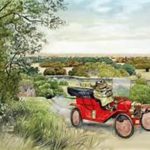
This time, he ends up in jail, but the jailer’s daughter helps him escape.
Study questions: Why would a toad want such a thing as an automobile? Did the author ever know a toad who drove a car? Toad was a terrible driver, and no wonder. How could he operate the controls, since he was so small?
Anyway, because of his thievery, he ended up in jail. That place was no fun. He was kept locked in a cage all day and fed only when the jailer felt like feeding him. His freedom was gone. How terrible! Perhaps the message here is an attempt to teach young ones to avoid jail at all costs. It’s a good thing the jailer’s daughter took pity on him.
The book has a happy ending, but you will have to read it to learn the rest of the story.
For a good adventure story, give this book a try, even if it doesn’t always make sense to you.
Call of the Wild
Hardcover; priced at $6.95
by Dover Publications (Prime shipping)
Written by Jack London
This story is about Buck, a large dog that is half St. Bernard and half sheep dog. Now, I don’t particularly like dogs, but I have to admire how this one overcame all the bad events of his life.
Buck lives on an estate in California, where he is very comfortable. Then he is kidnapped by the gardener on the estate and sold to dog traders. These traders beat him when he wouldn’t obey, and eventually send him to the Klondike gold fields.
I am a proponent of animal rights. I might not like dogs, but I think it was very wrong of these traders to mistreat this animal.
I understand the cold North, as I grew up here. However, life was not easy for Buck in his new job as a sled dog. When I think of pulling a big sled, I am very glad I am a cat. It would not be possible for me or even a team of cats to move such a heavy thing.
Buck begins remembering the instincts of his ancestors, and learns how to fight, find food and sleep beneath the snow on a winter night.
Buck and the lead dog, Spitz, become rivals, and eventually Buck kills Spitz and takes over as the lead dog. We cats do things a bit differently. We do get into fights, but they are not to the death. Mostly they are arguments over territory, or a scrap over a love competition. Not so these Alaskan sled dogs. Their fights could be vicious and deadly. I am glad the cat’s world is a bit different.
The big dog gets sold to another set of owners, inexperienced in living in the wilderness. These men overload the sled and beat the dogs. They run out of food and the dogs begin to starve, and weaker dogs soon die. It is very sad to me the way these animals are enslaved by their owners. We cats would never submit to enslavement. Have you ever tried herding cats?
They reach the camp of John Thornton with only five dogs. The men are still some distance from their destination, and decide to leave the camp despite their weak animals. Thornton advises them not to go, as the ice is melting. When the team owner urges the dogs to go anyway, Buck refuses to move. Buck’s owner begins to beat him, but Thornton knocks his knife from his hand and cuts Buck loose. The men, sled, and other dogs leave without Buck, and a quarter of a mile further, fall through the ice.
beat him, but Thornton knocks his knife from his hand and cuts Buck loose. The men, sled, and other dogs leave without Buck, and a quarter of a mile further, fall through the ice.
Thornton and Buck bond. It does my heart good to know that this mistreated animal finally finds the right owner.
Though Buck loves Thornton, he feels a growing attraction for the wild. As Thornton and his men search for a lost gold mine, Buck wanders the wilderness, making friends with wolves and hunting bear and moose. He always returns to Thornton now and then.
I believe Buck learns something most dogs never learn, and by learning it, he becomes much more cat-like. He learns to value his independence. Though bonded with Thornton, the dog becomes more and more like a wild animal, which is good. Once his master is gone, the dog can still take care of himself.
One day he comes back to find that Yeehat Indians have attacked and killed his master. Buck attacks the Indians, killing several, and the rest flee. Then he heads into the wilderness and becomes a leader of a pack of wolves. He is now a legendary hero.
Though this is a story about a dog, I found it quite thrilling and satisfying. It always makes me purr when a bad thing turns around and changes into a good one.
The Jungle Book (The Original 1894 Illustrated Edition)
by Rudyard Kipling
Hardcover; price $14.95 Prime shipping
This book was written in 1894, and was at first a collection of stories set in a forest in India. Rudyard Kipling, an English author, wrote it. I think Mr. Kipling must have had a cat, because he likes animals so much. Most of the characters are animals, except for Mowgli.
I think I would like the jungle, because it is such a wild place. It must have really leafy large trees. I would guess there are also lots of small creatures to hunt.
Mowgli, a very young boy, wanders from his village one day, and is attacked by Shere Khan, a cruel tiger. I think Shere Khan would have been nicer to me, because I would have brought him extra game to eat.
The boy is saved by Father Wolf, who asks Akela, the leader of the wolves, if the pack can adopt the boy. They give him the name of Mowgli, which means “the frog.”
I am ashamed of the role of my relative, the tiger, in this story. I think Shere Khan should have just “played” with Mowgli. The animal is evil, and kills just for the pleasure of it, and to show his strength. I do not believe in killing just for pleasure, but for food. Granted, it is fun to chase small creatures, and sometimes they are killed when they try to escape us. Some of us hunt them so we can eat them.
Birds, now, can be quite tasty, and the temptation to kill them is very strong. Of course, if we do, we normally eat the delicious meat. It does not go to waste.
Mowgli meets Bagheera, a panther, another of my wild cousins, and Baloo, the bear. These two speak for his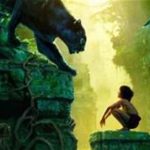 acceptance in the Seeonee wolf pack, and Mowgli becomes a wolf. Baloo is his teacher, and Mowgli learns jungle lore and the languages of jungle animals.
acceptance in the Seeonee wolf pack, and Mowgli becomes a wolf. Baloo is his teacher, and Mowgli learns jungle lore and the languages of jungle animals.
Something about this story puzzles me. How could Mowgli become a wolf without changing his form? That is not possible. I believe he became a wolf in name only.
Mowgli has many exciting adventures with his new family and friends. I can imagine that the jungle would be a great place to live. There are countless trees to climb. I think it would be fun to learn to swing from long jungle vines the way Mowgil and some of the other animals do.
After living in the jungle for many years, Mowgli eventually returns to live with his own kind. However, he cannot ever get his love for the jungle out of his heart. He visits whenever he can.
I would like to commend the behavior of my cousin Bagheera, the black panther, for being such a good friend to this small two-legged. We sometimes find friends in strange places.
Black Beauty
Hardcover; Price $12.81 Prime
By Anna Sewell
In a meadow in 19th century England, a young colt, Black Beauty, has been born. His mother raises him and teaches him lessons that he always remembers: Do good and give your best effort always and all will work out well.
I notice that these children’s books all seem to have lessons for young two-leggeds. I like this idea. Since the two-leggeds have speech and have devised something called writing to record their words, (as they have done in these books) they can teach in this way. We cats have to teach our young everything ourselves, one on one.
I have been around horses, but not much. I know that they will not harm us cats, unless they accidentally step on us. They are hay-eaters, and many of them are quite gentle. I think I might like this horse, Black Beauty.
As he grows up, Black Beauty is taught to accept riders. A horse must be very strong, so he can carry a two-legged on his back.
Beauty goes to a new home and is now owned by a man named Squire Gordon. He likes his new home, but misses the liberty of his youth, when he could run free in the meadow. Now he must accept his servitude.
The horses have a discussion over the flaws in their relationship with the two-leggeds. I can sympathize with their feelings. For example, they talk about owners cutting off their tails because it looks “fashionable,” a word with no significance to us cats. There is no consideration of the fact that the animal used that tail to swat away bugs. The horses conclude that the two-leggeds should just leave their animals the way they were intended to be and not change anything.
I must say, I agree. For example, from a cat’s point of view, I feel that removing our claws is not only wrong but cruel. We need those claws for defense and for hunting. Besides, removing our claws is an extremely painful experience for us. What if somebody suddenly decided that all the two-leggeds should have their fingernails and toenails removed? I can imagine the protests this decision would arouse.
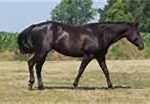 The story includes many of Beauty’s adventures. In one, the horse and a rider race to a destination town to find a doctor to come and treat the squire’s wife. Afterward, the horse becomes sick, and the new young groom is unable to care for him
The story includes many of Beauty’s adventures. In one, the horse and a rider race to a destination town to find a doctor to come and treat the squire’s wife. Afterward, the horse becomes sick, and the new young groom is unable to care for him
The groom’s father defends the boy, saying he meant no harm but was just ignorant. Then Black Beauty’s owner offers one of the main themes of the book: ignorance is as harmful as cruelty, despite the person’s good intentions.
It bothers me that in two of the six books I have reviewed, the owners of animals mistreat them terribly. I do not understand. The two-leggeds are so smart and have so many skills and advantages in their lives. Why would they stoop to treating the animals in their care so badly? It certainly does nothing to improve their image.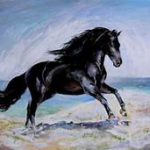
I am both amazed and hopeful to see that the two-leggeds do try to teach the proper behavior to their children. It just seems that sometimes the youngster refuses to learn. That is a sad thing. If a kitten refused to learn from its mother, it would not survive long.
Black Beauty endures some hard times and bad adventures. He goes through a series of owners. Once, when his shoes were not being properly maintained, on a journey his legs collapse. He has to go through a painful medical procedure that permanently scars his legs.
I am interested to learn that horses wear shoes. I thought these were reserved for two-leggeds. However, I can understand it. He has such a large body and skinny legs that the shoes must help him balance his weight. No wonder the legs collapsed.
Beauty’s story continues to be sad for a while, as some of his owners mistreat him in such ways that he ends up with long-term physical problems. At last he is bought by a couple of ladies with a house out in the country. It turns out that their groom is his old friend Joe Green, who was his groom in his earlier days of happiness. The story ends with Black Beauty finding peace and an enjoyable life once again.
I hope you have enjoyed these book reviews. My “boss” has put affiliate links with the books so you can click on them and get one for your household. Please be aware that if you order any of these books through Amazon, my CCL will receive a small commission.

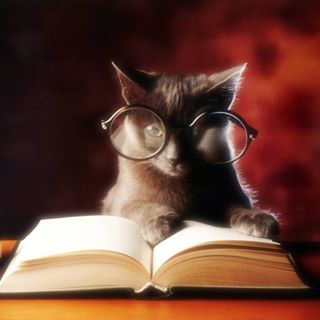






Hi Fran
This is the best post I have ever read on a website
I love Lucinda- she is a very humorous friend to have and she certainly knows how to do great book reviews that is for sure
I have bookmarked this post and will be sharing with lots of people I know who will enjoy this very much
Thank you and keep being awesome Lucinda
Oh, Vicki, you are so sweet! Thank you so much. Yours is my first reply. I hope I get some more positive ones, because I think Lucinda is going to get a six-week contract. I will have her do a review on a book a week, and will try to give you some more laughs. Thanks for sharing! Nothing is more helpful to me at this point.
This is definitely one very detail book review I’ve ever read. Your review indeed make my life easier. I was just about to buy a story book for my 9 years old niece. The Story of Peter Rabbit seem quite good and educational. Is it suitable for a 9 year old girl?
The story of Peter Rabbit would be a good choice for a 9 year old girl. I think she would enjoy it. Another one that might be great for a 9 year old is “The Wind in the Willows.” I remember I enjoyed that book a great deal when I was young. In fact, either that one or “Alice in Wonderland” might be good. If she reads a lot, I’d pick “Wind in the Willows,” as it might fit her age group better. Glad you liked the review.
This is a wonderful post from the perspective of the cat.I have always loved Alice’s Adventures in Wonderland. There has always been something magical about it, with Alice falling down the rabbit hole and all the adventures she gets into in Wonderland. It is such a facinating tale that they even made some movies featuring Alice.
Writing this post was really fun. How do you see things from an animal’s perspective? Of course, we have to just accept that Lucinda can read — but, after all, the rabbits all wear clothes, and the toad drives an automobile. I think I will “ask” Lucinda to do some more reviews in the future.
Hi Fran,
Loved your website, your beautiful header picture, drew me in straight away and meeting Lucinda, was a special treat.
Thank you so much, what a fantastic idea, reviews from a cat named Lucinda!
Lucinda needs to author a few books of her own!
Of course all of these books are such special favourites of ours, I love Beatrix Potter and especially love The Wind in the Willows.
Thank you, great website and beautifully presented.
Michele
I’m so glad you liked Lucinda’s work. I think I am going to give her a six-week contract, and ask her to write a summary/review on one book a week. That way she can stay in practice. As you will notice, none of those books is about cats, and the only cat is in “Alice in Wonderland.” So, I had to figure out a way to put books not in my niche into my website. Lucinda volunteered to help me out.
Hi,
Thanks for this unique review on Children Books. I definitely enjoyed reading your review because of how you prefectly blend humor and review on children books really well, and I can’t help from having fun and laughter while going through your article. Lucinda was doing a heck of a reviewed job afterall.
Oh, I am so glad you enjoyed it. Yes, Lucinda did a good job. I think I will give her a 6-week contract to write one book review a week. It adds a little humor to my website. Just had a thought…if you wanted to pick one of these books for your child, perhaps you should read this review to your child. Then the child could tell you which one was the favorite. Thanks much for your comments.
Dear Lucinda,
As another two-legged ancient creature, I can tell you for sure, that your catankerous cat lady is very pleased with your work.
Of course, she is your boss, so you’ll have to play a lot of cat-and -mouse before you get a rise or a lifetime contract, but don’t worry, the “truth” as you see it, will prevail.
In “The Tale of Peter Rabbit” Beatrix Potter said that “… these little books don’t last long even if they are a success” … Just give us more beautiful reviews Lucinda, and they will last forever!
What a nice comment! Thanks, Zsolt…and I, too, am rather pleased with Lucinda’s work…so much so that I’ve decided to issue her a six-week contract; one book review/summary, or perhaps two a week for the next six weeks. She’ll write just one summary, but if one book is too short, we will do two. Glad you liked the post.
Hello Fran,
I love you role reversal of the cat!
Very nice twist.
You have highlighted some beautiful books. They take me back a long way to my time in Spain when I read all of these books.
Alice in Wonderland is one of my favorite! your review is very thorough and accurate. The illustrations are beautiful.
I also had a look around your site and it is amazing. i love the jigsaw’s and the cat college is a wonderful idea.
Regards to your ‘boss’!
Tim
Glad you enjoyed meeting Lucinda. I had to do something…my theme is cats, and I couldn’t do the books myself, as I am not a cat. So, asked the cat to review them. It worked pretty well. Those books were among my favorites growing up as well.
What a wonderful list of books. Many I love and have in our library at home. My wife loves Beatrix Potter. Beatrix’s books are so clever, sweet, and her drawings are amazing. We read those over and over again to our kids growing up. Thanks for the list, it brought back wonderful memories.
Glad the books were familiar to you. I loved them when I was a kid. And what did you think of Lucinda’s interpretation of the books?
I love the theme of this website… A literate Cat and his old women. I have always been curious of a cat perspective on our two legged everyday habits.
Lucinda, the books you have reviewed here are definite classics that I read as a child and hope to someday read to my children if I have any. Is your two legged friend Fran going to the book store anytime soon to pick up more good literature?
I haven’t really told Lucinda yet, but am offering her a six-week contract to do a review of one or two books a week. I don’t think she will mind doing them.
I’ve lived with cats all my life and am continually amazed by them. It is interesting to try to figure out things from their perspective.
Wow! Lucinda is an amazing reviewer! So sorry Carlos is gone. Lucinda has a flair about her! She reminds me of the cantankerous cat lady! I love her descriptions of areas of the story. She leaves you wanting to know more! Is Lucinda going to continue reviews?
The cat feature shows at the end we’re so cute too!!
I loved these books as a child and so do my great-granddaughter’s! Please let the cantankerous cat lady know she is missed and loved.
I answered your comment once, and the computer ate it! So glad you liked Lucinda’s reviews. She will be doing more. I have hired her to do a review of a couple of books each week for six weeks. So be watching. Have you not seen my “Carlos” book, Mickie? I have it listed on this site. Go check it out — https://celebratingcats.com/have-you-found-your-purrfect-pet-companion. Actually, Lucinda learned how to read from Carlos, who made a great study in my Memory Library to learn our language. Chapter 10 of Carlos’s book is called “The Gospel According to Carlos,” and was written by him. Lucinda is a good understudy.
What a wonderful way to introduce the classics – through the eyes of a literate cat. I enjoyed reading each review and especially appreciated the perspective and the subtle humor.
You have created a wonderful site for sharing your feline knowledge and expertise.
Thank you, Annie! I sure had fun writing the story (with the cat’s help, of course. I just edited it and corrected spelling.)